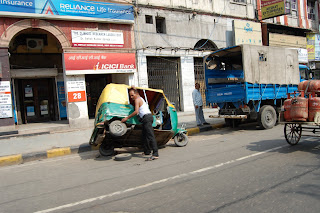Back from travels. Some thoughts I wrote down to share. I think the pictures speak for themselves, though these are only pictures from my camera. We took lots of pictures with Kobe's point-and-shoot camera that I will upload once he gets them to me.
Thailand-
I have never met so many hustlers in one place in my life. It felt like our entire time in Bangkok was spent trying to evade scam after scam.
Our first day in the country we were stopped and patted down by the police as we were taking a tuk-tuk back to our hotel. We never received a real explanation as to why - it may have had something to do with the 8 or so handcuffed Indians we saw at a local jail a few minutes later. Thankfully, we had our passports on us. Indians are hustlers too, which is why in this case proving we were not Indian was useful. Speaking of hustling, thanks to Kobe, we stayed 3 nights in a 4-star hotel for a total of 36 USD.
The same night, we went to one of the big night bazaars to shop and get food. Because the Thai are not so proficient in English, many hotels give their guests cards with directions back to the hotel written in Thai. After some decent street food and a few drinks, we haggled with a tuk-tuk driver to take us back to the hotel for 50 Baht. We handed over the card that the hotel gave us so that he would know where to go. As soon as we sat in the tuk-tuk, he pulled out the card and started to tear it in half, saying he wanted 100 Baht for the ride. Of course, he had no idea that we each had another card with directions on us, which we then showed him. At this point, he was clearly peaved. He popped a minimum of two wheelies in addition to driving like a maniac on the way back to the hotel. But we only paid 50 Baht. Scam averted. It was fun!
I have never seen prostitution as blatant as it was in Thailand. Interestingly, most Thais seem to accept that it happens - it wasn't just the prime tourist areas that were teeming with prostitutes. According to one book I read, "most" Thai men are adulterers.
We managed to chance upon the gay bar scene in Bangkok, which for two guys with little interest in taking home a Thai woman for the night, was great. I suspect male prostitution may be just as common in that district as female prostitution is in other parts. Even though we sat as far away from each other as possible, never shared a martini, and never fed each through interlocking arms (as was happening at the tables around us), nobody doubted the legitimacy of Kobe and I as a couple.
Thai food was at times great in Thailand, though on the whole, rather disappointing. Maybe I have grown too accustomed to Top Spice in Atlanta to appreciate what genuine Thai food is. The street food was generally very good, but the restaurant dining left something to be desired. Street food favorites included pad thai, mango sticky rice, and Thai iced tea. The green curry pictured in the photo was pretty good as well, with plenty of spice as I asked for. All in all, still better than Tofu Tina's.
The infrastructure in Bangkok is off the chain. I should have taken more pictures of the infrastructural marvels. I can't remember if Kobe did. Public transport - including a skytrain, metro, and water taxi system - coupled with cheap cabs made getting around the city easy. The malls and shopping centers in the heart of the city are all connected directly to public transit stations. The airport was a neat architectural feat as well.
It was a novel experience being in a place where Buddhism is predmoninantly practiced. Looking closely, I noticed many cultural, religious, and linguistic similarities between Thailand and India, not the least of which are ancient and modern Hindu temples that are run and supported by Thais. Linguistically, there are many mutually intelligible words.
The local Bangkokites seemed to not have a very favorable opinion of Indians. One coconut vendor nearly refused to sell me a Thai coconut (which if you've never had one, go find one now) because I was Indian and "love money." He then asked me if my Prime Minister (referring to Manmohan Singh) also loves money. I bet the Indians in Thailand are mostly businessman and are likely frugal, but I am not sure what (if anything) they have done to earn this reputation.
Cabs in Bangkok run on a meter. As we were heading to the airport at 5am, our hotel doorman flagged us down a cab and assured us we only needed to pay what the meter said. He confirmed this with the driver. About 1 km later, the driver gestured that the meter was broken and that he wanted 500 Baht for the trip. We were too tired to argue, but even on our way out we couldn't avoid being hustled.
I will post about Malaysia soon.























